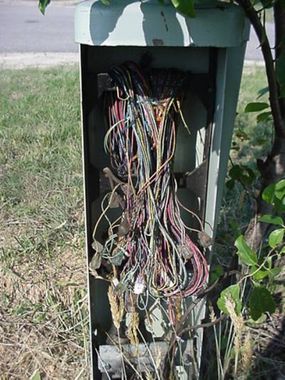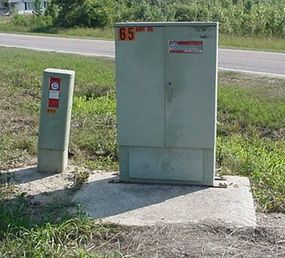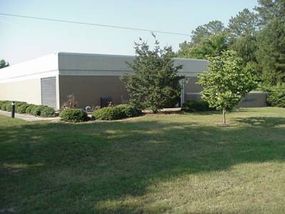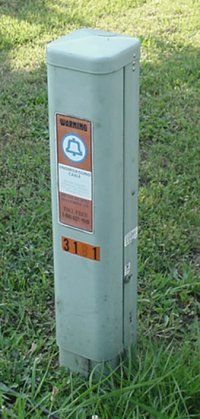If you have underground phone wiring in your neighborhood, as opposed to phone wiring that runs in the air on poles, then you will frequently see these little boxes all over your neighborhood -- one for every two or three houses or so. A typical box in the southeastern United States might look like this:
This box is two or three feet (about a meter) high and perhaps 8 inches (20 cm) square.
Advertisement
If you have read the HSW article entitled How Telephones Work, then you know that what runs into your house for each telephone line is a pair of copper wires. What is running through your neighborhood is a thick underground cable containing perhaps 25 or 50 pairs of copper wires. The little green box is a place where the 50-pair cable pops out of the ground so that a phone company employee can splice into it. They happen to be building a new subdivision nearby, and here is what one of the boxes looks like during construction:

You can see that this is a very simple installation. They've taken the cable, removed its outer protective sheathing to reveal all of the wires, and then spliced into several of the pairs for the two or three houses sharing the box (the small clear plastic blocks are the splices). Small two-pair cables run underground from the box to the houses. Sometimes the splices won't be quite this simple -- there will be a plastic or ceramic plate inside with a junction block instead of direct splices.
So where does the 25-pair or 50-pair cable come from? If you hunt around your neighborhood, you will find a larger box that looks like this:

This box is perhaps 4 feet or 5 feet high (1.5 meters). A larger cable with hundreds of wire pairs runs past this point, and one or more 25-pair or 50-pair wires gets its start here. Inside the box is a large punch-down panel where phone company employees attach each pair in the smaller cable to the correct pairs in the larger cable.
The larger cable will often get its start at a box like this:

This box is about 6 feet (2 meters) high and 12 feet (4 meters) wide. You can see on the right that this box also has its own power meter, and therefore has power (unlike the previous boxes, which have contained nothing but passive splices). Inside this large powered box are digitizers. The pairs from each house attach to the digitizers so that all of the phone calls in the area can be carried on a much smaller set of wires. This box might accept a number of larger lines (like T1 or T3 lines) carrying voice channels, and the digitizers break down the multiplexed lines into individual pairs. The multiplexed lines might travel down the road as copper, fiber optic or coaxial cables.
Eventually the multiplexed lines arrive at a switch which might look like this:

This building has no windows and is perhaps 50 feet (15 meters) square. See Question 354 for details on what happens at the switch!
Advertisement
